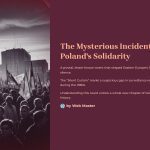 What really happened during the obscure episode involving Poland’s iconic Solidarity movement? This isn’t just about strikes or slogans—it’s about a pivotal, lesser-known event that shaped Eastern Europe’s future in silence. Recent historical investigations have reignited global interest in a specific moment during the 1980s when communication was mysteriously cut off between key Solidarity leaders and Western allies. This moment, often dubbed “The Silent Curtain,” marks a suspicious gap in surveillance records, telephone archives, and diplomatic correspondences. Why does no one talk about it? Was it a cover-up? A betrayal? Or the moment that saved Solidarity from being dismantled? Understanding this could unlock a whole new chapter of Cold War history. And as Poland repositions itself in today’s global political dynamics, echoes of that mystery remain more relevant than ever.
What really happened during the obscure episode involving Poland’s iconic Solidarity movement? This isn’t just about strikes or slogans—it’s about a pivotal, lesser-known event that shaped Eastern Europe’s future in silence. Recent historical investigations have reignited global interest in a specific moment during the 1980s when communication was mysteriously cut off between key Solidarity leaders and Western allies. This moment, often dubbed “The Silent Curtain,” marks a suspicious gap in surveillance records, telephone archives, and diplomatic correspondences. Why does no one talk about it? Was it a cover-up? A betrayal? Or the moment that saved Solidarity from being dismantled? Understanding this could unlock a whole new chapter of Cold War history. And as Poland repositions itself in today’s global political dynamics, echoes of that mystery remain more relevant than ever.

The Rise of Solidarity: A People’s Cry for Freedom
Solidarity, or Solidarność in Polish, began not as a political revolution but as a labor rights movement rooted in the Gdańsk Shipyard. In 1980, under the leadership of Lech Wałęsa, shipyard workers demanded better working conditions, freedom of speech, and the right to form independent trade unions. This was unprecedented in a Soviet satellite state, where such liberties were tightly controlled by the regime.
As the movement gained traction, it evolved into a national platform for democratic change. By late 1981, Solidarity had amassed over 10 million members—nearly a third of the Polish population. However, this mass mobilization sparked concern in Moscow and among Communist elites in Warsaw. Martial law was declared in December 1981, suppressing the movement. But this wasn’t the end—it was the beginning of the underground resistance and, perhaps, the mysterious event that still defies full explanation.

The Vanishing Signal: How Communications Suddenly Ceased
In the spring of 1982, following months of underground resistance, Solidarity leaders attempted to coordinate a Europe-wide solidarity campaign. According to newly declassified intelligence documents and eyewitness testimonies, during one crucial week, all outbound communications from Gdańsk were abruptly cut off. Radio signals were jammed, phone lines dead, and even diplomatic cables went unanswered.
This anomaly, known in niche circles as “The Vanishing Signal,” has never been officially explained. While state authorities at the time blamed ‘technical difficulties’, whistleblowers from inside the Ministry of Internal Affairs suggest otherwise. Some believe this was the moment when Solidarity was about to expose covert Soviet involvement in Poland’s political repression to the West—but someone, or something, intervened.

Western Reaction: Silence or Strategy?
The West’s response to the communication blackout was strikingly subdued. Rather than protest or raise alarms at international forums, U.S. and European leaders issued mild statements of “concern.” Was this strategic restraint or an indication of deeper geopolitical games at play?
Some historians argue that NATO had been warned by secret Polish informants not to intervene, suggesting that an overreaction could have prompted a Soviet invasion. Others claim Western intelligence agencies knew of a rogue faction within the Polish security services that was cooperating with the Vatican to protect key Solidarity leaders. The truth remains hidden under layers of classified documents.

A Hidden Pact? Theories of Internal Compromise
What if the silence wasn’t a suppression—but a survival strategy? A growing number of Polish scholars believe that certain Solidarity leaders may have struck a temporary ceasefire deal with high-ranking Communist officials. This covert pact, they argue, involved allowing the leaders to escape arrest in exchange for a temporary media blackout.
If true, this would radically alter the narrative of Solidarity’s pure defiance. It suggests pragmatic choices were made to preserve the movement long enough to resurface at a safer moment. Lech Wałęsa’s mysterious absence from public view during this time has only fueled these theories. Despite his later Nobel Peace Prize and presidency, critics argue that some chapters of his leadership remain suspiciously undocumented.

Unsealed Archives: New Clues from the East
Thanks to recent efforts by international journalists and Polish archivists, previously sealed Soviet files have started to shed new light on this obscure event. KGB communication logs reference a “Z-point” alert in Poland during that week—an internal code used for political destabilization threats. Another document, uncovered in 2023, shows a request for rapid deployment of surveillance drones near Gdańsk, suggesting preparations for either repression or rescue.
These revelations add credibility to the belief that something extraordinary happened—but that its exposure could have escalated the Cold War beyond control. While the full truth remains elusive, each document pulls us closer to the heart of the enigma.

Echoes Today: Why This Still Matters in 2025
Fast forward to the present: Poland is a proud member of the EU and NATO, but debates about surveillance, political autonomy, and foreign interference are once again center stage. The lessons from Solidarity’s mysterious week remind us how fragile freedom movements can be—and how quickly they can be manipulated or silenced.
In today’s digital age, where communication is presumed invincible, the idea that an entire movement could be momentarily erased from the global grid is both chilling and instructive. This incident underscores the importance of independent media, transparent government archives, and global watchdogs in preserving democratic momentum.
*Capturing unauthorized images is prohibited*


